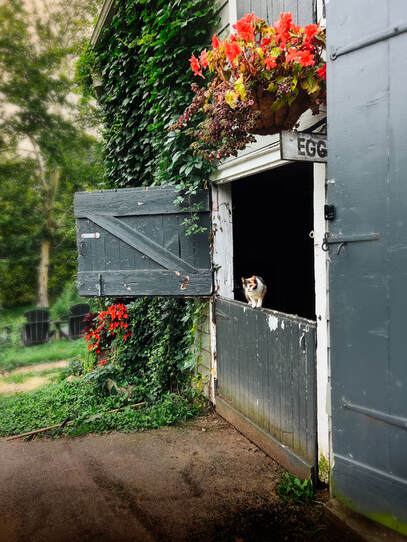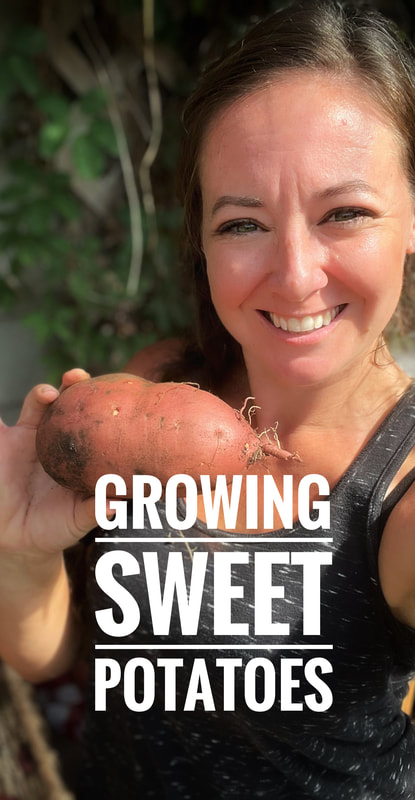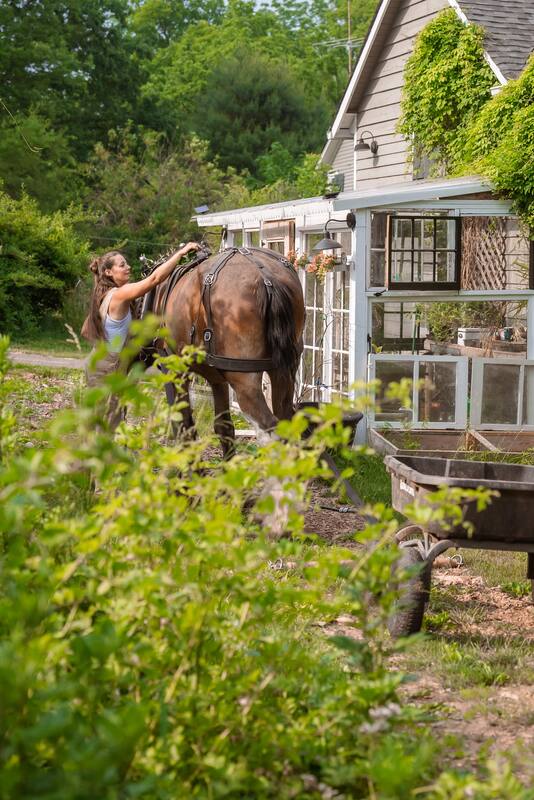|
This year I installed a Mediterranean guild home to olives, artichokes, rosemary, lavender and thyme. While I chose varieties most suitable to my climate, I’ve researched artichoke winter care and here’s what I’m installing. We are getting our first freeze this evening (these plants have successfully withstood frosts already) so it’s time to hibernate these artichokes for the season.
I start by tying the leaves of the artichoke plant together in a bundle. This protects the crown. After tying, I cut the leaves off just above the string or twine. The remaining standing bundle is roughly 6-8" in height. I choose to mulch the surrounding soil and other guild members with the trimmed artichoke leaves. I also add chopped comfrey leaves as a green manure at this time along with fallen maple, oak, or other dried leaves from around the farm. An upside pot is affixed on the artichoke bundle for protection from the elements. To secure the pot in place over the winter months, I top the pot with a rock. Bedding or mulch can be added around the base of the pot to make sure gaps are filled in where the pot makes contact with the soil. Imperial Artichokes can withstand frosts so once winter temperatures begin to ease and we head back into the spring season, I'll be removing the protective pot. From there the bundles will be untied and new growth will be allowed to emerge. Our Holland Lop rabbits live the good life outdoors (with shelter) all spring, summer and fall. They graze on cover crops from our raised beds and other food growing spaces by spring. Come summer and fall, they graze the pastures and laws with the ducks and geese from the safety of their bun run. And in the winter, they retire inside the old duck and goose coop for extra protection from the cold. I'm sharing my set up, bedding, and thoughts on winter rabbit housing.
You can find the Bun Run video here Permaculture Duck and Goose Living video here You can also find the products I mentioned from Eaton Pet & Pasture here: Hemp Pet Bedding Nesting Pads Cover cropping seems to be trendy and there's good reason for it--this "green manure" adds loads of nutrients and organic matter to gardens and growing spaces. I was suspicious the first time I was sowing cover crops; that there was more hype than real benefit. But I was shocked at the visible difference and improvement in my soil.
Cover crops are not harvestable like a vegetable or fruit crop. Instead, they're grown for the nutrients, cover, and tilth improvement they offer soil. In the fall cover crops can be sown into the garden. They grow and protect soil all winter long, preventing erosion, solarization, and runoff. Come spring, the cover crops are chopped and dropped, grazed, or removed (I have another video on that). Ideally the crop would be chopped and allowed to decompose in place. Any nutrients left in the plant during its lifecycle is returned to the soil as it decays, also increasing the amount of organic matter. I use a mix of cover crops to perform multiple functions; soil cover, weed reduction, to loosen compacted soil, to attract beneficial insects at spring thaw, fix nitrogen, phosphorous, potassium, and pull soluble nutrients up from soil layers. I purchased this pre-mixed blend from True Leaf Market. You can also research cover crop varieties and their benefits at the Rodale Institute's website and create your own blend. Time Stamps: Organizing Bulbs 0:53 / Permaculture Benefits 3:15 / Mulching with Hemp 4:42
This past May I visited a tulip farm out in Washington called Roozengaarde. I was intrigued by the blooms thriving in partial shade, under pine trees, and in visibly poor soil. Before getting caught up in the view and spending loads of money on bulb orders, I did a little research on the contributions tulips make to the permaculture garden (if any). Turns out, these beauties offer a lot more than just a view. Where I visited and purchased bulbs from: https://www.tulips.com/ Varieties I planted include Brisbane, La Belle Epoque, Frozen Night, Charming Beauty, Charming Lady, Red Princess, Louvre Orange, Black Hero, and Gudoshnik. Hemp mulch is from Eaton Pet and Pasture (chopped hemp animal bedding): https://www.amazon.com/Eaton-Hemp-Hypoallergenic-Sustainable-Eco-Friendly/dp/B08LQTRFG8 Time Stamps: Forsythia 1:05 / Goumi 1:41/ Sea Berry 2:06 / Food Forest DIY 3:12
Autumn Olive (aka Russian Olive) grows abundantly on my property, in my county, and in my state. As we move through our food forest areas, we're replacing this beautiful, edible, yet invasive specie with a more appropriate alternative. 1. Forsythia doesn't have edible fruit, however, its blossoms are edible in spring. This grower spreads quickly, however, isn't currently on the USDA's list of invasive species. The blossoms also attract hummingbirds and pollinating insects and offer shelter during the winter months for small birds, insects, and wildlife. These shrubs grow well in poor soils, on banks and hillsides, and create dense hedges for privacy. Great for soil erosion too. 2. Goumi offers edible berries that are tart and more suitable for cooking or jam making than eating raw. These plants fix nitrogen into the soil, assist with erosion by holding soil in place, grow 6-10' tall and wide, and are self-fertile. They thrive in USDA growing zones 4-9. Goumi doesn't mind poor soil OR poor air quality and has no major pest or disease issues. 3. Hypophae / Sea Berries / Sea Buckthorn are thick growing shrubs which produce thorns to protect their edible berry clusters. The small berries are an orange-yellow color and are said to taste like a cross between a pineapple and citrus. The berries contain 7x more vitamin C than lemons and provide a food source to the home, resident birds and wildlife. The Sea Berry is suited for zones 2-9 and fixes nitrogen into the soil. To produce fruit, a male and female plant is needed (note one male to every four female plants). While it thrives in full sun, on hillsides, in poor soil, and in many soil consistencies, this shrub hates shade so isn't on the invasive species list by the USDA. The sunflowers that require no annual planting: meet sunchokes (aka wild sunflowers) and Maximilian sunflowers. Of course they bring a sunflower vibe to growing spaces, but also have all the perks of perennials for the environment.
Tubers loosen compacted soils, blossoms feed pollinators, the woody plant tissue absorbs more carbon from the atmosphere than annual plants, they create a safe haven for predatory insects and birds, and they are edible. It’s said Maximilian sunflowers were planted around homes by the early settlers to deter mosquitos, and when their tubers are dried and added to bath water, they relieve pain and inflammation due to arthritis. And let’s not forget to mention the stunning living wall these plants create. Both sunchokes and Maximilian sunflowers spread by way of edible tubers. Therefore it's essential to plant these crops in a location with moist but well-draining soil. Too much standing water is cause for root rot, and will not only affect the harvestable roots but also threaten the life and productivity of the plants. If plants are allowed to continue to multiply without harvesting the tubers, a dense living wall will remain that can spread more and more every season. Meet Garlic, a new kitten here named by my kids. ☺️ Every addition is a balance on the homestead between what the farm needs and what nature already provides. As a permaculture practitioner, I assess every single element before bringing in something new… this is how an ecosystem is maintained.
In this case, we were down to one barn cat. I knew we’d likely need another before the temperatures plummet… a barn full of hay and animal feed (no matter how well protected) is a welcoming spot for country mice and rats. I waited to see what our resident rodent and owl populations were like, how many predatory inhabitants we have that could access the barn realistically with guard dogs around, and what stray cats (if any) might come by. Too many cats could reduce a food source other wildlife needs to survive so I wanted to be sure we had enough prey to support another cat. If I take a food source away from owls, kestrels, fox, etc., they’ll be more likely to prey on my birds or leave the farm all together; neither of which is the intention. And because this is social media, yes, I feed my cats multiple times per day. 😉 And so it was meant to be. We welcomed Garlic a few weeks ago. A skittish but most welcome new farm friend.
Sweet potatoes aren’t really potatoes. They’re tropical plants with edible roots in the morning glory family. As such, the harvest should be cured differently to create a sweeter flavor.
- Start by planting after the last frost. You can do slips or plant an entire sweet potato. Make sure the soil is loose and nutrient-dense as these are heavy feeding plants. - Apply a dense layer of straw or mulch at planting time to retain moisture and prevent weeds. I do 10-12” thick. Grow undisturbed all season—no pruning of vines is necessary. - Stop watering about 7-10 days before you plan to harvest. This prevents cracked skin on the potatoes. - Harvest with your hands if possible by carefully moving back the vines, soil, and mulch. Lift without a shovel to avoid puncturing the potatoes. - Sweet potatoes need heat and humidity to cure. I harvest mine when the forecast shows temps are soon to dip and the plant begins to yellow. Do not wash the tubers. - A shady dry table outdoors is great for curing. Sweet potatoes need 80°F+ temps and 90% humidity according to The Farmer’s Almanac. Cure for two to three weeks before storing long term in a dark, cool, aerated location. - Sweet potatoes are an amazing ground cover in food forest systems and also do well when grown with sunflowers! NOTE: deer LOVE sweet potato vines Use a Byproduct from Prepping Dirty Produce to Give Your Soil a HUGE Boost: Permaculture Diary9/1/2023
Nothing is wasted. Capturing and storing energy. These are a couple of the permaculture principles I’m employing by soaking my carrots in water for 12 hours before processing, and then reclaiming that micro-organism filled water for my garden and compost heap.
Right after harvesting carrots and other root crops, it’s essential to remove the greens. Otherwise they’ll continue to pull water from the root. This can leave your carrot, turnip, or radish for example, wilted if it had to keep supplying the green tips with hydration. To restore any lost water and to loosen dirt and debris on the outside of the vegetable, I soak my carrots for 8-12 hours post harvest, after the greens have been removed. The next day, when I’m processing the carrots, I’m left with water that contains all the soil from my garden. That garden soil was created using a mix of growing soil, compost, and organic matter I’ve built up over time. By allowing it to soak in the water and breathe overnight, micro bacteria in that soil begins to multiply. Essentially, we’re creating compost tea from the soil deposits on the outside of the crops. This nutrient dense liquid can be applied to the garden directly. Instead I prefer to add mine to my compost heap. Scraps from vegetable processing are a great compost additive —but liquid compost is even better since it’s full of helpful microbes. If you're new to this space, I’m Angela. The best visual I can think of to illustrate what I’m trying to build is a small farm in France called La Ferme du Bec Hellouin. This is what I’m trying to create in central New Jersey: a thriving homestead resilient to climate change using permaculture methods.
I’m not your typical homesteader. I’m using animals and cover crops to restore once-depleted and dead soil. I place great priority on planting perennial crops and overstory trees. I invite wildlife into our farm ecosystem where nature is at the forefront of every decision. And every animal has at least one job that contributes to our ecosystem. As a result we are thriving despite heavy wildfire smoke, flooding, and drought. My homestead was build in 1775, but it’s only been under my direction for about 8 years. Already we have seen an increase in beneficial insects, birds, butterflies and wildlife. All while growing enough food for our family. I hope you’ll stick around. For more information on Le Ferme du Bec Hellouin, please click here. You can also find their book, Miraculous Abundance, here. |
Angela is the farmer and content creator behind Axe & Root Homestead® LLC. This historic six-acre permaculture farm is home to two Clydesdale horses, ten honeybee hives, five sheep, two guardian dogs, barn cats and a flock of 40 geese and ducks. The farm produces maple syrup, fruit from a small orchard and loads of garden produce for consumption, preservation and donation to the local food pantry.
The Sustainable Homestead is available NOW!
Categories
All
|



